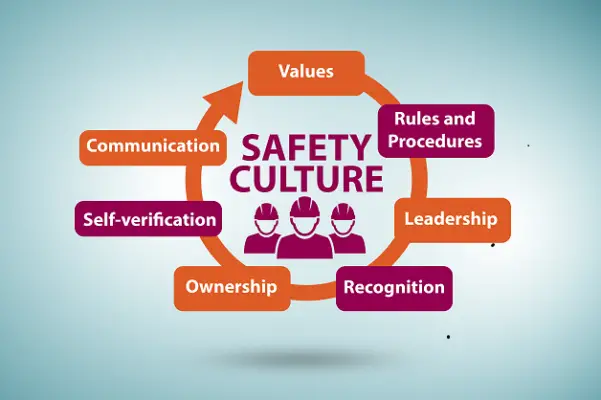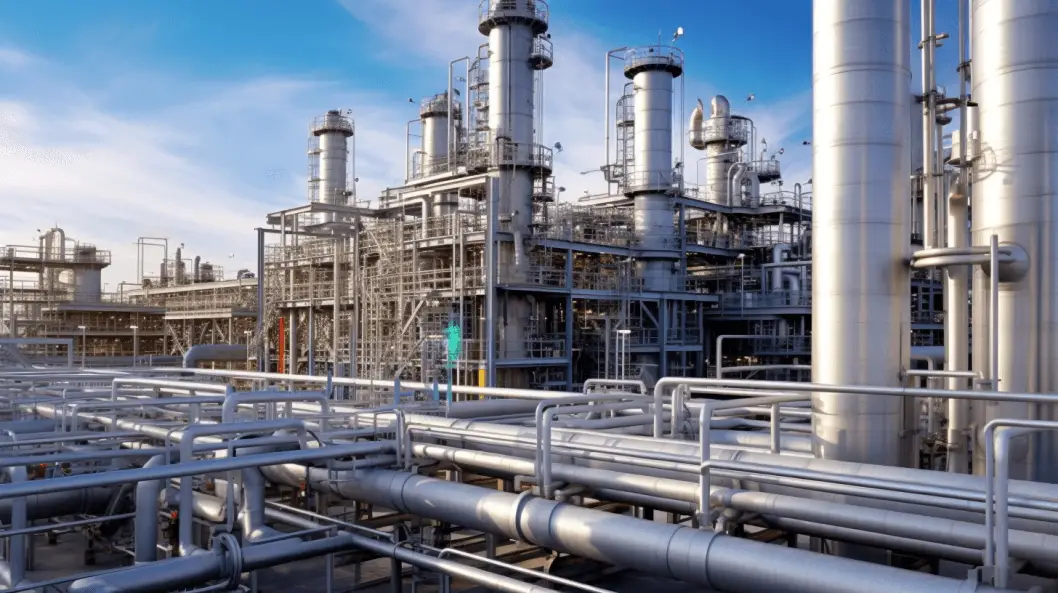Liquefied Natural Gas (LNG) is a rapidly growing industry that has become a popular alternative to traditional fuels. As the demand for LNG continues to increase, it is essential to ensure that the handling and transportation of LNG are conducted safely and efficiently.
Risk assessment is a crucial aspect of LNG transportation and handling, as it helps to identify and mitigate potential hazards associated with the process.
The risk assessment of LNG involves evaluating the potential hazards associated with the handling, transportation, and storage of LNG.
This process includes identifying potential hazards, assessing the likelihood of their occurrence, and determining the potential consequences of an incident.
The assessment also considers the effectiveness of existing safety measures and identifies any additional measures necessary to reduce the risk further.
By conducting a thorough risk assessment, companies can ensure that they are adequately prepared to handle any potential hazards associated with the transportation and handling of LNG.

LNG Basics
Liquefied Natural Gas (LNG) is natural gas that has been cooled to -162°C (-260°F) and condensed into a liquid state.
This process reduces the volume of natural gas by 600, making transporting over long distances easier and more cost-effective. LNG is odorless, colorless, and non-toxic, making it a safe and reliable energy source.
Natural gas is a fossil fuel primarily composed of methane, although it can also contain small amounts of other hydrocarbons such as ethane, propane, and butane.
Natural gas is extracted from underground reservoirs and transported through pipelines to processing facilities, where it is purified and compressed.
LNG is typically transported in specialized ships called LNG carriers, designed to keep the LNG at its extremely low temperature.
The LNG is stored in insulated tanks on board the ship and is unloaded at a receiving terminal, where it is regasified and distributed through pipelines to customers.
As an energy source, LNG has several advantages over other fossil fuels. It produces fewer emissions than coal or oil, making it a cleaner-burning fuel.
It is also abundant and widely available, with reserves around the world. Additionally, LNG is flexible and can be used for various applications, including power generation, heating, and transportation.
Overall, LNG is a valuable energy source that has the potential to play an important role in meeting the world’s growing energy needs.
Its use is expected to grow in the coming years as more countries look to diversify their energy mix and reduce their dependence on traditional fossil fuels.
LNG Industry Overview
The liquefied natural gas (LNG) industry has grown significantly in recent years, driven by increased global demand for natural gas.
LNG is natural gas that has been cooled to -162°C, which reduces its volume by 600 times, making it easier and more cost-effective to transport over long distances.
The LNG industry is a crucial component of the global economy, as natural gas is an essential source of energy for power generation, heating, and industrial processes. According to the International Energy Agency, natural gas is expected to account for 25% of global energy demand by 2040, up from 23% in 2017.
The global gas market is highly competitive, with many countries vying to become major players in the LNG industry.
The United States, Russia, Australia, and Qatar are among the largest producers of LNG, with Qatar being the largest exporter of LNG in the world.
LNG imports are also an essential component of the global gas market, with many countries relying on imported LNG to meet their energy needs.
Japan, South Korea, China, and India are among the largest importers of LNG, with China being the fastest-growing market for LNG imports.
Import terminals are critical infrastructure for countries that rely on imported LNG. These terminals receive, store, and regasify LNG, making it available for power generation, heating, and industrial processes.
Import terminals are also subject to strict safety regulations to ensure LNG’s safe handling and transport.
The LNG industry is crucial in the global economy, providing a reliable energy source for power generation, heating, and industrial processes.
The industry is highly competitive, with many countries vying to become major players in the market.
LNG imports are also essential, with many countries relying on imported LNG to meet their energy needs. Import terminals are critical infrastructure for countries that rely on imported LNG, subject to strict safety regulations to ensure the safe handling and transport of LNG.
Design and Operation of LNG Facilities
LNG facilities are designed and operated with safety as a top priority. The inherent characteristics of LNG are considered during the design phase, and safety measures are implemented to prevent or mitigate any potential risks.
Designing an LNG facility involves a comprehensive risk assessment process that considers all aspects of the facility’s construction, operation, and maintenance.
The risk assessment process is based on internationally recognized standards and guidelines such as ISO/TS 16901:2022 and ISO/TS 18683:2021.
The design of an LNG facility considers various factors such as the location, environmental conditions, and the type of LNG facility being constructed.
For example, onshore LNG facilities may require impoundment structures around LNG tanks and pipelines to control the spread of LNG in the event of a release.
Similarly, offshore LNG facilities may require additional safety measures such as fire suppression systems and emergency response plans.
Once the LNG facility is designed, it undergoes rigorous testing to meet all safety requirements. The facility is then operated in accordance with strict safety protocols and procedures.
These protocols cover all aspects of the facility’s operation, from LNG handling to equipment maintenance.
LNG pipelines are also designed and operated with safety in mind. The design of an LNG pipeline considers factors such as the pipeline’s location, the type of terrain it will traverse, and the type of LNG being transported.
The pipeline is then constructed in accordance with international standards and guidelines to ensure its safety.
Ports that handle LNG shipments are also subject to strict safety regulations. These regulations cover all aspects of the port’s operation, from handling LNG vessels to loading and unloading LNG cargoes.
The port’s safety protocols are designed to prevent accidents and mitigate any potential risks.
Finally, LNG bunkering facilities are also designed and operated with safety as a top priority. Bunkering involves transferring LNG from one vessel to another, and safety measures are implemented to prevent any accidents or spills.
The bunkering facility’s safety protocols cover all aspects of the bunkering process, from handling LNG to maintaining equipment.
In summary, the design and operation of LNG facilities, pipelines, ports, and bunkering facilities are all subject to strict safety regulations and protocols.
These regulations and protocols are designed to prevent accidents and mitigate any potential risks associated with the handling and transporting LNG.
Safety Measures in LNG Operations
Safety is a top priority in the liquefied natural gas (LNG) industry, and rigorous safety measures are in place to protect workers, the public, and the environment.
One of the key safety measures in LNG operations is training. Workers who handle LNG must be well-trained and knowledgeable about the properties and hazards of LNG, as well as the safety procedures and protocols in place.
This includes training on emergency response procedures, fire prevention, and suppression, and the use of personal protective equipment.
Another important safety measure in LNG operations is the use of simultaneous operations. This involves conducting multiple activities simultaneously, such as loading or unloading LNG while performing maintenance work.
By carefully coordinating these activities and implementing strict safety procedures, companies can minimize downtime and increase efficiency while maintaining a safe working environment.
Ship-to-ship (STS) transfers are another area where safety measures are critical. LNG is transferred directly from one ship to another during an STS transfer.
This requires careful planning and coordination, as well as specialized equipment and personnel.
Safety procedures must be in place to prevent spills and leaks, and emergency response plans must be in place in case of an incident.
In addition to these measures, companies also implement a range of other safety measures in LNG operations, including:
- Regular safety audits and inspections.
- Use of safety equipment such as fire suppression systems and gas detectors.
- Implementation of safety management systems.
- Use of risk assessment tools to identify and mitigate potential hazards.
LNG industry is committed to maintaining the highest safety standards and continuously improving safety measures to protect workers, the public, and the environment.
Risk Assessment in LNG Industry
The LNG industry is subject to stringent safety regulations to prevent and mitigate the risk of accidents. Risk assessment is an essential component of the safety management system in the LNG industry.
Risk Assessment Method
The risk assessment method used in the LNG industry is a combination of qualitative and quantitative risk assessment.
Qualitative risk assessment is used to identify the hazards, while quantitative risk assessment is used to evaluate the risk associated with the identified hazards.
Hazard Identification
Hazard identification is a critical component of risk assessment in the LNG industry. The hazards associated with the LNG industry include fire, explosion, and release of hazardous materials.
The industry has developed hazard identification tools, such as failure mode effect analysis (FMEA), to identify the hazards associated with LNG facilities.
Risk Reduction
Risk reduction is an essential component of the safety management system in the LNG industry.
The industry has developed various risk reduction measures, such as preventative, control, and mitigation measures, to reduce the risk of accidents.
The risk reduction measures comply with the severe design and managing criteria established by the relevant industry’s standards, such as NFPA 59A, US DOT 49 CFR 193, and BS-EN 1473, CSA Z276-07.
Safety Record
The LNG industry has an excellent safety record due to implementing preventative, control, and mitigation measures.
The industry’s safety record is a testament to the effectiveness of the safety management system in the LNG industry.
In conclusion, risk assessment is an essential component of the safety management system in the LNG industry. The industry’s safety record is a testament to the effectiveness of the safety management system in the LNG industry.
The industry has developed various risk reduction measures to reduce the risk of accidents.
Hazard Analysis
Hazard analysis is essential in assessing risks associated with handling and transporting liquefied natural gas (LNG).
The main objective of hazard analysis is to identify potential hazards and evaluate their likelihood and consequences.
The hazards associated with LNG facilities can be broadly categorized into seven categories, including cryogenic, toxic, and flammable fluids. The consequences of these hazards depend on what they expose and whether they are ignited.
One of the most significant hazards in LNG facilities is the uncontrolled release of LNG. Such a release can result in a pool fire, which can cause severe damage to the facility and surrounding areas.
Additionally, a spill can lead to a fire or explosion if the LNG vapor comes into contact with an ignition source.
To assess the potential consequences of an LNG spill, hazard analysts use models to simulate the behavior of LNG in various scenarios. These models consider factors such as weather conditions, terrain, and the properties of the spilled LNG.
In addition to modeling, hazard analysts use risk matrices to evaluate the likelihood and consequences of different scenarios. A risk matrix is a tool that combines the likelihood of an event with its consequences to determine the overall risk level.
Overall, hazard analysis is a critical component of LNG risk assessment. It enables stakeholders to identify potential hazards, evaluate their likelihood and consequences, and develop mitigation strategies.

Regulations and Standards
LNG risk assessment is a crucial part of ensuring the safety of LNG facilities and the surrounding environment. To achieve this, various regulations, standards, and recommended practices have been established to guide LNG facilities’ design, construction, and operation.
The Department of Energy (DOE) and the Department of Transportation’s Pipeline and Hazardous Materials Safety Administration (PHMSA) are the primary regulatory bodies responsible for overseeing the safety of LNG facilities in the United States.
PHMSA’s LNG safety regulations are codified in 49 CFR Part 193, which prescribes safety standards for LNG facilities used in the transportation of gas by pipeline that is subject to federal pipeline safety laws (49 U.S.C. 60101 et seq.) and 49 CFR Part 192. 49 CFR §193.2001 establishes the scope of Part 193.
On the other hand, the DOE is responsible for establishing safety standards for LNG facilities that are not subject to PHMSA regulations.
In addition to these regulations, several standards and recommended practices have been developed to guide LNG facilities’ design, construction, and operation.
One of the most widely recognized standards is the DNV GL Recommended Practice (RP) DNVGL-RP-F111, which provides guidance on LNG facilities’ safety and risk management.
This standard covers all aspects of LNG facility design, including the selection of materials, equipment, and systems, as well as the development of safety management systems and emergency response plans.
Other standards and recommended practices that are relevant to LNG risk assessment include the American Society of Mechanical Engineers (ASME) Boiler and Pressure Vessel Code, the International Organization for Standardization (ISO) standards, and the National Fire Protection Association (NFPA) codes and standards.
Overall, compliance with these regulations, standards, and recommended practices is crucial for ensuring the safety of LNG facilities and the surrounding environment.
By following these guidelines, LNG facility operators can minimize the risk of accidents and ensure that their facilities are designed, constructed, and operated safely and responsibly.
Security Considerations
Regarding LNG risk assessment, security is a critical aspect that needs to be considered. The safety of LNG operations can be affected by security threats, such as terrorism, piracy, or sabotage. Therefore, it is important to ensure adequate security measures are in place to mitigate these risks.
One of the main security concerns in the LNG industry is the transportation of LNG by tankers. LNG tankers are large vessels transporting large quantities of LNG across the oceans.
These tankers are vulnerable to attacks from pirates, terrorists, or other hostile entities. Therefore, security measures need to be implemented to protect these tankers from such threats.
To address these security concerns, various organizations have developed guidelines and standards for the security of LNG operations.
For example, the International Maritime Organization (IMO) has developed the International Ship and Port Facility Security (ISPS) Code, which provides a framework for the security of ships and port facilities.
The ISPS Code requires that all LNG tankers have a security plan and that the crew be trained in security procedures.
In addition to the ISPS Code, other organizations have developed guidelines for the security of LNG operations.
For example, the American Petroleum Institute (API) has developed Security Guidelines for the Petroleum Industry, guiding LNG security measures.
Some of the security measures that can be implemented to mitigate the risks associated with LNG operations include:
- Physical security measures, such as fencing, lighting, and surveillance cameras.
- Access control measures, such as security gates and identification badges.
- Security training for personnel, including crew members and shore-based staff.
- Emergency response plans for security incidents.
- Regular security assessments and audits to identify vulnerabilities and risks.
Security is a critical aspect of LNG risk assessment that needs to be considered to ensure the safety of LNG operations.
Adequate security measures need to be implemented to protect LNG tankers and other facilities from security threats.
Environmental Impact of LNG
Liquefied Natural Gas (LNG) is often touted as a cleaner alternative to coal, but it is not without its environmental impacts. While it has lower greenhouse gas emissions than coal when burned, the process of producing, transporting, and storing LNG can have negative consequences for the environment.
Greenhouse Gas Emissions
LNG is primarily composed of methane, a potent greenhouse gas responsible for a significant portion of global warming.
While natural gas has lower greenhouse gas emissions than coal when burned, methane leaks during the production and transport of LNG can offset these benefits.
According to a study published in the journal Nature, LNG’s life cycle greenhouse gas emissions can be higher than coal’s if methane leaks exceed 3.2% during the production and transport process.
Environmental Degradation
The production and transport of LNG can also have negative impacts on the environment. LNG facilities require significant energy to liquefy natural gas, which can contribute to air pollution and carbon emissions.
The construction of LNG facilities can also lead to habitat destruction and fragmentation, harming local wildlife populations.
Spills and Accidents
LNG spills and accidents can also have significant environmental impacts. LNG is stored and transported at extremely low temperatures, and any leaks or spills can release large amounts of methane and other harmful gases.
In addition, LNG spills can result in fires and explosions, which can cause significant damage to the environment and surrounding communities.
Overall, while LNG may have lower greenhouse gas emissions than coal when burned, the production, transport, and storage of LNG can have negative environmental impacts.
It is important to consider these impacts when assessing the overall environmental impact of LNG as an energy source.
LNG and the Economy
Liquefied natural gas (LNG) has become an increasingly important commodity in the global energy market. LNG is a cleaner-burning fuel that emits significantly less carbon dioxide than coal or oil.
This has increased demand for LNG, especially in countries looking to reduce their carbon footprint.
However, LNG imports face three main economic risks: natural gas prices, import costs, and demand fluctuations.
Natural Gas Prices
The price of natural gas is a significant factor in determining the profitability of an LNG project. Natural gas prices can be volatile, and fluctuations can significantly impact project economics.
Various factors, including supply and demand, geopolitical events, and weather patterns, influence the price of natural gas.
LNG projects must consider these factors when assessing the long-term viability of their projects.
Import Costs
Import costs are another significant factor in determining the economic viability of an LNG project. Import costs include the cost of shipping LNG from the production site to the import terminal, as well as the cost of regasification.
Regasification is the process of converting LNG back into natural gas, which can be transported through pipelines to end-users.
Regasification costs can be significant and depend on the design and location of the import terminal.
Demand Fluctuations
Demand fluctuations are a significant risk for LNG projects. LNG projects require significant upfront investment, and they have long lead times. This means that LNG projects must make assumptions about future demand when making investment decisions.
If demand does not materialize as expected, LNG projects can become uneconomical. The COVID-19 pandemic has highlighted the risks associated with demand fluctuations in the LNG market, as demand for LNG has fallen significantly due to reduced economic activity.
LNG projects must carefully assess the economic risks of natural gas prices, import costs, and demand fluctuations. While LNG has significant potential as a cleaner-burning fuel, economic considerations are crucial in determining the long-term viability of LNG projects.
Frequently Asked Questions
What are the safety measures taken during LNG transportation?
The transportation of LNG is subject to strict safety regulations to minimize the risk of accidents. The safety measures include the use of double-hulled ships, which provide an additional layer of protection against leaks or spills.
The ships also have advanced navigation and communication systems to ensure safe transport.
Additionally, LNG carriers are designed to withstand extreme weather conditions and must follow specific routes to avoid potential hazards.
What are the environmental risks associated with LNG?
The production and transportation of LNG can have environmental impacts, including greenhouse gas emissions and the potential for spills or leaks.
Natural gas extraction, which produces LNG, can have negative environmental effects, such as water pollution and habitat destruction.
To mitigate these risks, regulatory agencies require companies to conduct environmental impact assessments and implement measures to minimize their impact.
What is the impact of LNG spills on marine life?
LNG spills can significantly impact marine life, depending on the size and location of the spill.
LNG is lighter than water and vaporizes quickly, which can lead to the formation of a flammable cloud that can ignite.
The resulting fire can cause significant damage to marine ecosystems, including fish and other wildlife.
LNG carriers are subject to strict safety regulations to minimize the risk of spills and must follow specific routes to avoid sensitive areas.
What are the safety regulations for LNG facilities?
LNG facilities are subject to strict safety regulations to ensure the safe production, storage, and transportation of LNG.
The regulations cover a range of issues, including the design and construction of facilities, the training of personnel, and emergency response planning.
The regulations are enforced by regulatory agencies, such as the Pipeline and Hazardous Materials Safety Administration (PHMSA).

How are LNG risk assessments conducted?
LNG risk assessments are conducted to identify potential hazards and develop mitigation strategies.
The assessments consider various factors, including the design and construction of facilities, the transportation of LNG, and the potential impact of spills or leaks.
Trained professionals conduct the assessments and are subject to review by regulatory agencies.
What emergency response plans are in place for LNG accidents?
LNG facilities and carriers must have emergency response plans in place to respond to accidents or spills. The plans include procedures for notifying authorities, evacuating personnel, and containing and cleaning up spills.
Regulatory agencies review and approve the plans and are subject to regular testing and evaluation to ensure their effectiveness.

Chris Ekai is a Risk Management expert with over 10 years of experience in the field. He has a Master’s(MSc) degree in Risk Management from University of Portsmouth and is a CPA and Finance professional. He currently works as a Content Manager at Risk Publishing, writing about Enterprise Risk Management, Business Continuity Management and Project Management.

